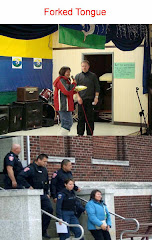Who are the main activists in the battle to free the KI6?
The grassroots of KI, other First Nations, social justice activists,
environmentalists and human rights organizations.
Who are the main activists in the battle of silence and diplomacy?
Clever men and (a few women), aboriginal and non-aboriginal based in
cities far from the grassroots on the rez, who are at home in meetings in hotel rooms, executive and
legislative offices.
Some leaders would like to channel the KI fight into business as usual
negotiations.
I think that is a mistake.
The only thing we can count on to force Ontario to make better
decisions is pressure. Negotiation rides the wave of pressure, it does
not create pressure.
Negotiations are an exercise in illusion.Once leaders become enmeshed in a web of relationships with officials and private groups, external resources(government funding, lawyers and consultants) become a substitute for the grassroots.
When the protests at KI and elsewhere subside, the external resources will be withdrawn and the organization built on talk and meetings will face collapse.And it will be too late to suddenly decide to build pressure.
The problem is to identify strategies by which local protests can influence centralized decisions.
If every First Nation actively demanded that Ontario meet all its lawful
obligations to consult and accommodate, the bureaucracy would be
overwhelmed and forced to make concessions. In the McFauld's Lake nickel/base metals boom there are more than 40 companies on the ground. Has the Crown met the duty to consult? Not on your life. Could the affected First Nations flood the system with demands that the Crown meet the duty if they were not already enmeshed in negotiations with the companies? Of course.
A policy of silence and diplomacy will achieve very little, while a
politics of turbulence can achieve quite a lot.




